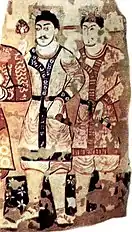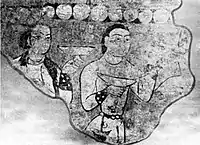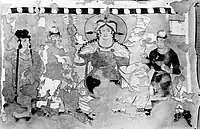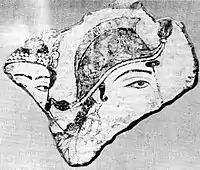Dilberjin Tepe
Dilberjin Tepe, also Dilberjin or Delbarjin, is the modern name for the remains of an ancient town in modern (northern) Afghanistan. The town was perhaps founded in the time of the Achaemenid Empire. Under the Kushan Empire it became a major local centre. After the Indo-Sassanids the town was abandoned.
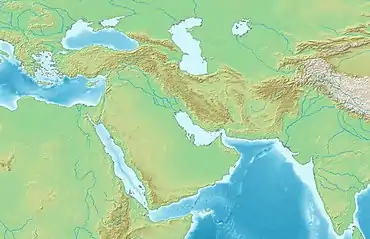
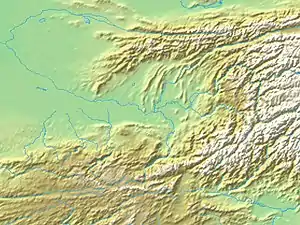

Archaeological remains
The town proper was about 390 x 390 m large. Dilbarjin had a city wall built under the Kushan rule. In the middle of the town there was a round citadel, built at about the same time. In the North-East corner of the town was excavated a temple complex. Here were found many wall paintings, some in a purely Hellenistic style. Originally the temple was perhaps dedicated to the Dioscuri, of which a mural in Hellenistic style has been recovered.[1] A long inscription in the Kushan language was also discovered, dated to the early great Kushans, around the period of Kanishka I, on paleographic grounds, as it seems slightly younger than the inscription of Surkh Kotal.[2] Outside the city walls there were still substantial buildings. Finds include inscriptions in Bactrian, most of them too destroyed to provide any historical information. There were fragments of sculpture and many coins.
Wall paintings
The paintings of Dilberjin Tepe belong to the 5th-6th century CE, or even as early as the 4th century CE according to some authorities, based on numismatic evidence.[3][4] The paintings have some similarity with those of Balalyk Tepe, and some from Bamiyan.[4] A comparison with the swordsmen at Kizil Caves would also suggest a date from the 5th century to the early 6th century CE.[5] The same authors consider that the paintings at Balalyk Tepe are about a century older than the paintings at Dilberjin, dating from the end of the 6th century to the early 7th century CE.[6]
These murals are general thought to represent Hephthalites, with their characteristic tunics with a single lapel folded to the right, cropped hair and ornaments.[7][8][9]
A famous mural shows a row of warriors in kaftan, relatively similar to the mural from Kyzyl.[10]
A much later fresco showing an Indian scene, with Shiva and Parvati on the bull Nandi, has been dated to the 8th century CE.[11][12]
Coinage
Coins of many period are found at the site, including Hephthalite coins, but coins of the Kushano-Sasanians and the Kidarites were the most numerous from the early Sasanian period to have been found on the site.[13] About 72 such coins were found, belonging to Ardashir I, Peroz I, Hormiz I, as well as each type of the Varahran I, that is, the coins first struck under Varahran, and then those struck on the model of Varahran by the Kidarite rulers Kirada, Peroz and Kidara I.[13][14] These coins suggest that the murals themselves should be dated to the late 4th century CE or early 5th century CE at the latest.[15][16]
References
- Muzio, Ciro Lo. The Dioscuri at Dilberjin (Northern Afghanistan): Reviewing their Chronology and Significance. pp. 43, page 67 Fig.1.
- "Les fouilles de la mission archéologique soviéto-afghane sur le site gréco-kushan de Dilberdjin en Bactriane" (PDF). Comptes rendus des séances de l'Académie des Inscriptions et Belles-Lettres: 412, Fig.7. 1977.
- Dani, Ahmad Hasan; Litvinsky, B. A. History of Civilizations of Central Asia: The crossroads of civilizations, A.D. 250 to 750. UNESCO. p. 183. ISBN 978-92-3-103211-0.
- "Furthermore, the style of the later paintings [of Diberjin Tepe], which are comparable to those of Balalyk Tepe and to the oldest frescoes at Panjīkant, both in Sogdia, indicates a date in the 5th-6th centuries C.E., according to some authorities (Belenitskiĭ and Marshak), whereas others argue from the numismatic finds that the final phase cannot have been later than the end of the 4th or the early 5th century C.E. (Vaĭnberg and Kruglikova, 1976; idem, 1984; Pugachenkova, 1984, p. 105).""DELBARJĪN – Encyclopaedia Iranica". www.iranicaonline.org.
- Dani, Ahmad Hasan. History of Civilizations of Central Asia: The crossroads of civilizations: A.D. 250 to 750. Motilal Banarsidass Publ. p. 151. ISBN 978-81-208-1540-7.
- Dani, Ahmad Hasan. History of Civilizations of Central Asia: The crossroads of civilizations: A.D. 250 to 750. Motilal Banarsidass Publ. pp. 151–152. ISBN 978-81-208-1540-7.
- "Among the Hephthalites (in Dilberjin and Balalyk-tepe, in the scene of the royal couple in Bamiyan) upper thrown-open clothes form dominated" in KURBANOV, AYDOGDY (2010). THE HEPHTHALITES: ARCHAEOLOGICAL AND HISTORICAL ANALYSIS (PDF). Berlin: Berlin Freie Universität. pp. 135–136.
- "Furthermore, the style of the later paintings [of Diberjin Tepe], which are comparable to those of Balalyk Tepe and to the oldest frescoes at Panjīkant, both in Sogdia, indicates a date in the 5th-6th centuries C.E., according to some authorities (Belenitskiĭ and Marshak), whereas others argue from the numismatic finds that the final phase cannot have been later than the end of the 4th or the early 5th century C.E. (Vaĭnberg and Kruglikova, 1976; idem, 1984; Pugachenkova, 1984, p. 105).""DELBARJĪN – Encyclopaedia Iranica". www.iranicaonline.org.
- Ilyasov, Jangar. "The Hephthalite Terracotta // Silk Road Art and Archaeology. Vol. 7. Kamakura, 2001, 187-200": 187–197. Cite journal requires
|journal=(help) - Dani, Ahmad Hasan; Litvinsky, B. A. (1996). History of Civilizations of Central Asia: The crossroads of civilizations, A.D. 250 to 750. UNESCO. p. 151. ISBN 978-92-3-103211-0.
- Pugachenkova, G.A. Kushan Art (PDF). p. 331 Fig. 9.
- Muzio, Ciro Lo. The Dioscuri at Dilberjin (Northern Afghanistan): Reviewing their Chronology and Significance. pp. 59, drawing in Page 71 Fig 17.
- Cribb, Joe. The Kidarites, the numismatic evidence.pdf (PDF). p. 107.
- Cribb, Joe. The Kidarites, the numismatic evidence.pdf (PDF). pp. 91–146.
- Dani, Ahmad Hasan; Litvinsky, B. A. History of Civilizations of Central Asia: The crossroads of civilizations, A.D. 250 to 750. UNESCO. p. 183. ISBN 978-92-3-103211-0.
- "Furthermore, the style of the later paintings [of Diberjin Tepe], which are comparable to those of Balalyk Tepe and to the oldest frescoes at Panjīkant, both in Sogdia, indicates a date in the 5th-6th centuries C.E., according to some authorities (Belenitskiĭ and Marshak), whereas others argue from the numismatic finds that the final phase cannot have been later than the end of the 4th or the early 5th century C.E. (Vaĭnberg and Kruglikova, 1976; idem, 1984; Pugachenkova, 1984, p. 105).""DELBARJĪN – Encyclopaedia Iranica". www.iranicaonline.org.
- "Les fouilles de la mission archéologique soviéto-afghane sur le site gréco-kushan de Dilberdjin en Bactriane" (PDF). Comptes rendus des séances de l'Académie des Inscriptions et Belles-Lettres: 407–427. 1977.
- Dani, Ahmad Hasan; Litvinsky, B. A. (1996). History of Civilizations of Central Asia: The crossroads of civilizations, A.D. 250 to 750. UNESCO. p. 151. ISBN 978-92-3-103211-0.
- Pugachenkova, G.A. Kushan Art (PDF). p. 331 Fig. 9.
- Muzio, Ciro Lo. The Dioscuri at Dilberjin (Northern Afghanistan): Reviewing their Chronology and Significance. pp. 59, drawing in Page 71 Fig 17.
Literature
- Warwick Ball: Archaeological Gazetteer of Afghanistan : Catalogue des sites archéologiques d'Afghanistan, Paris 1982, p. 91-92
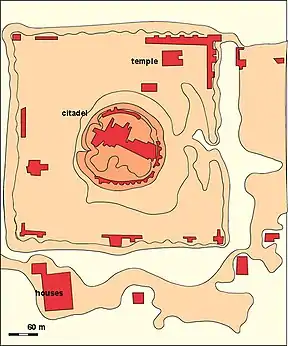
_I_Balkh_mint_Struck_under_Kidarite_king_Kidara_circa_CE_350-365.jpg.webp)
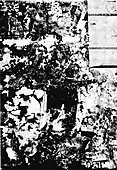
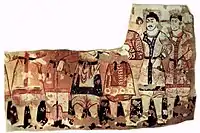
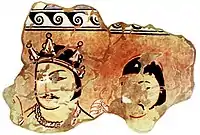
.jpg.webp)
